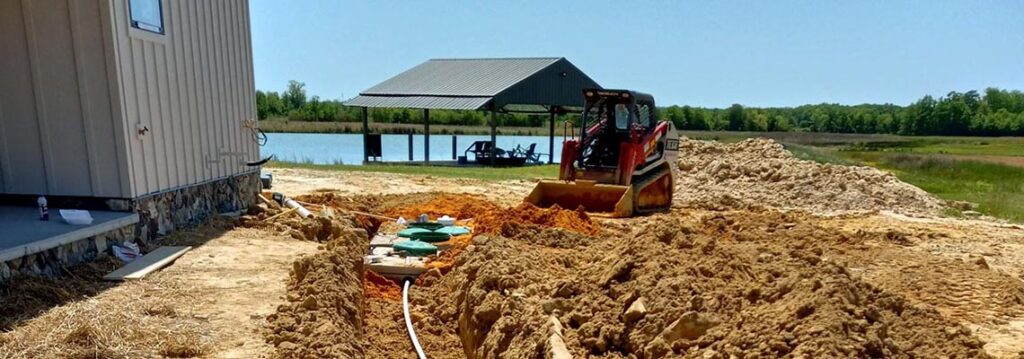
How Much Does It Cost to Install a Septic Tank in Alabama?
As an Advanced Licensed Level II Installer with over two decades of experience serving Alabama homeowners, one of the most common questions I get asked is: “How much does it cost to install a septic tank in Alabama?” Well, that’s a big question, let’s go over it.
The truth is, there’s no one-size-fits-all answer. The final price can vary depending on several factors. I’ll share some insights from my perspective and provide tips for budgeting your project.
Understanding Septic System Costs
First, let’s clarify that when we say septic tank we mean “septic system.” it’s a complete wastewater treatment process for homes not connected to a municipal sewer system.
Here are the key components:
Septic tank: A buried container where wastewater from your home settles. Solids sink to the bottom (sludge), while lighter materials like oils and greases float to the top (scum).
Drainfield: A network of pipes buried beneath a rock-filled trench. Partially treated wastewater from the tank flows through the pipes and into the surrounding soil, where it’s naturally filtered and purified.
The K & K Septic Experience: A Baseline for Concrete Tanks
Here at K & K Septic, we use concrete septic tanks for our installations, unless some special circumstance dictates using something else. Concrete is a great choice for durability, affordability, and long lifespan (generally 20-30 years with proper care). Based on our experience, installing a new septic system with a concrete tank in Alabama is between $5,000 to $12,000 including all materials, labor, permitting fees, and inspections.
Factors Affecting Septic System Installation Costs
Let’s delve into the specifics that can influence the final price:
The size of the tank depends on the size of your house and the expected wastewater flow rate. More showering and flushing mean a bigger tank. K & K Septic will conduct a site evaluation to determine the optimal tank size.
Size of the drainfield: The size of the drainfield is determined by the soil conditions on your property. Soils with good drainage capabilities require a smaller drainfield, while less permeable soils necessitate a larger one. Your drainfield needs enough space for the wastewater to disperse into the ground.
Soil conditions: The type of soil on your property impacts installation costs. Clayey or rocky soil is more challenging to work with, conversely, sandy or loamy soils are easier to dig through, leading to lower labor costs.
Local permitting fees: Obtaining permits from your county health department before septic system installation is mandatory. The associated fees can vary depending on your location, K and K Septic handles all of this for our clients and only charges what the permits cost, other companies may include service charges for pulling permits.
Considerations Beyond the Basics
Accessibility of the installation site, a difficult-to-reach property may require additional equipment to reach and can add to the cost.
Depth of the drainfield: The depth required for the drainfield can also affect the price. Shallower drainfields are generally less expensive, but they may not be suitable for all soil types or water tables.
Need for additional features: In some cases, additional features like effluent pumps or sand filters might be necessary depending on your specific situation. These will add to the overall cost.
Getting an Accurate Quote
The best way to determine the exact cost of installing a septic system on your property is to get quotes from qualified professionals who can assess your specific needs, evaluate your soil conditions, and provide a detailed breakdown of the anticipated costs. At K & K Septic, we offer free consultations and estimates.
Get multiple quotes, don’t settle for the first quote you receive, not even ours. Compare prices and installation times offered by different septic companies. Based on our volume of work, K and K Septic usually offer better products at a lower cost with a faster install time.
Beyond the Price Tag
While cost is definitely a crucial factor, here are some additional considerations for a successful septic system installation:
Experience and reputation: Choose a licensed and experienced septic system installer with a proven track record. Look for positive reviews and testimonials from past clients, you can even ask for references.
Permits and regulations: Ensure the company you choose handles all necessary permitting and inspections.
Quality materials: Don’t compromise on quality. Reputable companies use high-quality, durable materials built to last.
Conclusion
Taking the time to understand what affects the cost of septic system installation, getting multiple quotes, and comparing services and experience, will help you make an informed decision. A properly installed and maintained septic system can provide reliable wastewater treatment for your property for decades to come. A poorly installed system will cost more to fix than it did to install.
If you have any questions about septic system installation in Alabama or would like a free consultation and estimate from K & K Septic, don’t hesitate to give us a call! We’re always happy to help.
If you have any questions about septic system installation in Alabama or would like a free consultation and estimate from K and K Septic, don’t hesitate to give us a call! We’re always happy to help.
P.S. In addition to the information above, here are some resources you might find helpful:
Alabama Department of Public Health – Onsite Sewage and Disposal Systems
Alabama Onsite Wastewater Board
After reading this article from K & K Septic and reviewing these resources, you’ll be well-equipped to navigate the septic system installation process in Alabama.
